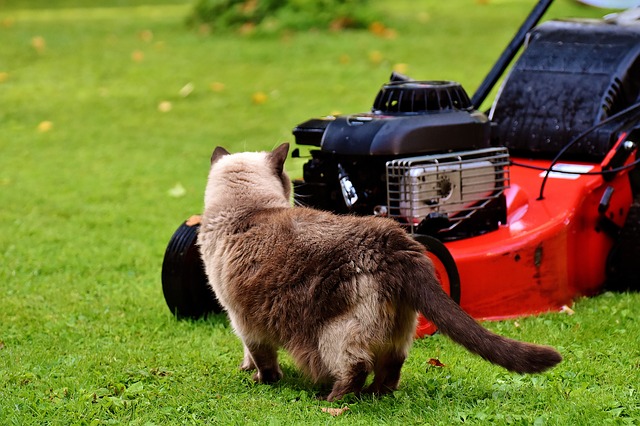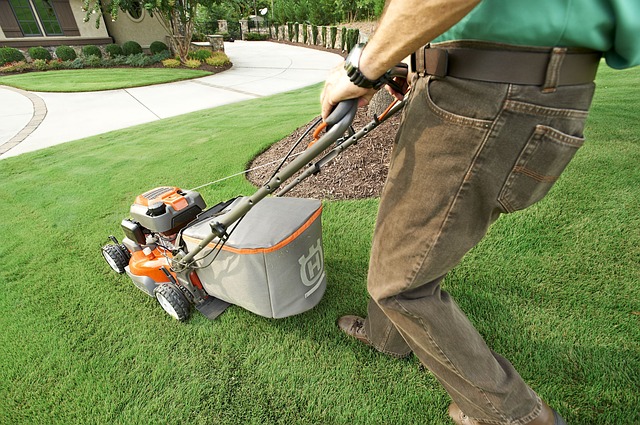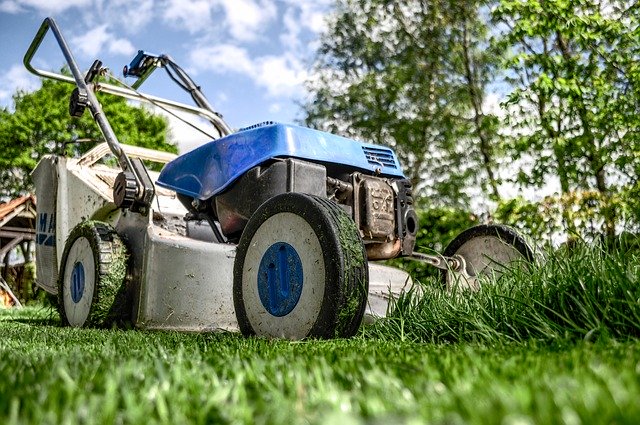Spring is in the air, your grass is shaggy, and you’re ready to cut the lawn. But if your mower has been sitting in your shed all winter, you may find yourself wondering how to fix a lawn mower that won’t start.
How do you fix a lawn mower that won’t start? You’ll need to troubleshoot it and identify the problem. You may need to change the spark plug, replace the carburetor, replace the filters, or just replace the fuel.
A gas-powered mower needs fuel and a spark to get going, and a number of things can get in the way. Fuel may not be getting from the carburetor to the engine. It may have a blocked fuel line, which means it may start but then die as soon as you start cutting.
Troubleshooting a Stubborn Lawn Mower
It’s not unusual for a gas-powered mower to have trouble starting after sitting in a garage or shed for months. Even here in the South, our lawns go dormant and don’t need mowing when the days are short. So, an idle lawnmower can become a troubled lawnmower.
The following tips on how to fix a lawn mower that won’t start should help you correct minor problems. The fixes are simple enough for most people. Try these quick fixes first before taking your mower to the repair shop or replacing it completely.
Before You Start
Before you start trying to figure out how to fix a lawn mower that won’t start, you need to take some safety precautions:
Wear Protective Equipment
Working on a lawn mower can mean cuts and scrapes from sharp metal edges, so work gloves are a must. Eye protection will also keep metal shards and gas fumes out of your eyes.
Disconnect the Spark Plug
Before troubleshooting a lawn mower that won’t start, disconnect the spark plug wire. It may bend back toward the plug and make contact, so cover the connection with electrical tape. Then tape it down as far from the plug as you can. Then, set the throttle to “stop”

What Causes a Lawn Mower Not to Start?
If you’re not sure how to fix a lawn mower that won’t start, begin with two of the most common issues that you can easily rectify.
Replace the Fuel
If you didn’t drain out any leftover gas before storing your mower for the winter, try replacing it. Exposure to heat, humidity, and oxygen can cause it to degrade, which means it may not work.
It may also have taken on water. Ethanol is a common additive to gasoline sold in the U.S. Unfortunately, it also absorbs water from the air, which ends up in your gas tank. And this means it can cause all sorts of damage to your mower’s engine.
So, check the fuel tank for old gasoline and replace it.
DO make sure you dispose of unused gasoline according to your local regulations. Check with a local auto parts store, as many offer this service.
Check the Mower’s Air Filter
Next, take the air filter out of your mower and check it. If you have a paper filter, you’ll need to replace it.
If you have a sponge-type filter, you can try cleaning it:
- Remove the air filter cover and filter
- Clean with diesel fuel, gasoline, or a specialized cleaner
- Squeeze out all cleaner until it no longer drips and let dry.
- Once dry, replace it and replace the cover.
Now that you have fresh gas and a clean filter, try starting your lawn mower again. If it still fails to start or the lawn mower starts and then dies, you can move on to the next troubleshooting steps.
Spark Plug and Wire
Start with the spark plug wire, checking it for cracks or frays. The connection should fit tightly onto the plug.
Then take a look at the spark plug. Remove the plug and check for physical damage. If you see any, you should replace it. Changing the spark plug on a lawn mower is a quick, cheap, and easy fix.
If it’s not damaged, it may be gapped incorrectly. However, you can clean it, check it and gap it using the following video from lawn mower manufacturer Briggs & Stratton.
Once you’ve checked or replaced the spark plug, replace it, reconnect it, and set the throttle to start on the mower and give it another try.
- Part# 496018s in display packaging
- Replaces Briggs & Stratton Service Part #496018S
- For Selected OHV Engines
- Replaces RC14YC
- Genuine Briggs & Stratton Part
- Briggs & Stratton 591868
- New OEM Spark Plug
- Genuine Briggs & Stratton Part
- Replaces Old Briggs # 799876
- material type: Plastic, No substitutes when it comes to keeping engine powered equipment healthy, to maximize engine life
- Please check your complete engine numbers with the description to confirm your correct part
- Fits most Honda small engines
- Interchanges and will fit other small engines using these spark plugs
- Genuine OEM NGK Part
If it’s still stubborn and won’t start, it’s time to check the carburetor.
Clean the Carburetor
Carburetor problems are second only to spark plug issues when it comes to figuring out how to fix a lawn mower that won’t start. It can also cause your mower to run roughly or stall out.
Remove the air filter again and check your mower’s carburetor. You’ll need to check the inside to ensure that it’s clean and functioning. If fuel is not getting from the carburetor to the engine in your mower, use automotive carburetor cleaner.
Lawn mower carburetor replacement isn’t complicated, but if you’re itching to get to the yard work, try cleaning it first. A few quick shots of carb cleaner into the device works, but avoid any plastic parts if possible.
Then, reassemble and try starting your mower again. If it still refuses to start, try checking the vent in the gas tank cap.
Fuel Tank Cap and Primer
If your mower has a fuel tank with a vent hole, make sure it isn’t clogged. A clogged hole forms a vacuum in the tank, preventing the fuel from flowing.
Simply unscrew the camp to let air bank into the tank. Then clean out the vent with a wire.
Then check the primer button. Some mowers have rubber push-button primers that can deteriorate. You may need to replace it. Luckily, it’s a simple job and you can find plenty of videos that show how to replace the one on your machine.
Common Lawn Mower Problems
Now that you know how to fix a lawn mower that won’t start because of the most common problems, you’ll want to know how to deal with other problems that often come up.
How to fix a lawn mower pull cord
There are a couple of common problems that make the pull cord on your lawn mower hard to pull.
- Safety bar not tightly pressed to handle
- Mower sitting in tall grass that prevents the blade from rotating
- Mower deck caked with wet grass
Lawn Mower Loses Power When Blades Engaged
If your lawn mower is losing power when you’re mowing, it’s most likely because your grass is too tall, too thick, or even too wet.
First, check that the deck isn’t clogged with grass. Then, raise the blade a notch to see if that resolves the problem. You may have to raise it by several settings until you get it high enough that the wet grass doesn’t stall out your mower.
You can lower the blade and make another pass on your lawn, but if wet grass is the problem, you’re better off waiting for it to dry.
If Your Lawn Mower Is Smoking
Overfilling and oil spills are the primary cause of a smoking lawnmower. You can wipe up any excessive spills with paper towels and then run the machine and let the oil burn off.
If your mower is smoking and running roughly or stalling out, however, you’ll probably need to have it checked by a professional.

When Your Brand New Lawn Mower Won’t Start
Nothing is as frustrating as buying an expensive new machine for your yardwork only to have it fail on day one.
Before boxing it back up for the return desk, try a few of these tricks:
Priming
New mowers may have air in the fuel line and combustion chamber. So, make sure you prime it before starting it. Check the manual for priming directions.
Fuel Tank
Your new mower may have been a floor demo. So, check it to see if the retailer put fuel in the tank. If it’s been sitting around with fuel in the tank, you’ll need to replace it.
Two-Stroke Engines
Some mowers have two-stroke engines and some have four-stroke engines. While four-stroke engines use regular gasoline, two-stroke models are more complicated.
Two-stroke engines require a mix of gas and oil to run, so check your owner’s manual and follow the directions to the letter.
Choked Off
Some manufacturers ship lawn mowers with the choke in the closed position. This blocks how much air can get into the carburetor, which will prevent your brand new lawn mower from starting.
Open the choke to increase the airflow until it starts and stays running. Then return the chock to the normal position as indicated in your manual.
Cutoff Switch
Some new gas-powered mowers come with a safety switch that cuts off the fuel. If your mower has an electric starter, check the manual to see if it has a cutoff switch too.
These safety switches can make getting a brand new lawn mower started difficult if you’re not used to them. But they can prevent gas leaks and accidents.
Conquer the Mower, Conquer the Lawn
You now know a few tricks for how to fix a lawnmower that won’t start. Hopefully, you were able to get your trusty mower working and get out on that turf.
However, if none of these tips resolved the problem, it may be time to call a repairman. Call the manufacturer first, though, in case they have any other tricks to try. At the very least, they can help you find a repair shop in your locale experienced with their products.
Last update on 2024-07-27 / Affiliate links / Images from Amazon Product Advertising API
This product presentation was made with AAWP plugin.









